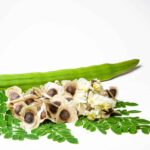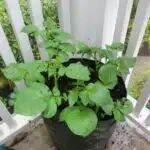Ginger, a spice that is widely used in cuisines across the world, has been cultivated for thousands of years. It is not only a flavorful ingredient but also has numerous health benefits. Ginger plants are relatively easy to grow and care for, making them a great addition to any home garden. In this comprehensive guide, we will discuss everything you need to know about growing and caring for ginger plants, from selecting the right variety to harvesting and storing the root.
What is Ginger?
Ginger is a perennial herb that belongs to the Zingiberaceae family, which includes other popular culinary herbs such as turmeric and cardamom. The ginger root, or rhizome, is part of the plant that is commonly used in cooking and for its medicinal properties. The rhizome is a knobby, brownish-yellow tuber that grows underground and has a pungent, spicy flavor.
Benefits of Growing Ginger
Growing your own ginger plants not only provides a fresh supply of this flavorful spice but also has many other benefits:
- It is easy to grow and care for, making it a great choice for beginner gardeners.
- Ginger plants are attractive and can be used as ornamental plants in the garden.
- Ginger has many health benefits, including anti-inflammatory properties and aiding in digestion.
- Ginger can be used in a variety of culinary dishes, from sweet to savory, adding a unique and delicious flavor.
Choosing the Right Ginger Variety
When it comes to growing ginger, selecting the right variety is important. There are many different varieties of ginger, each with its own unique flavor and growing requirements. Some popular varieties of ginger include:
- Common Ginger (Zingiber officinale): This is the most commonly grown variety of ginger and is the type found in most grocery stores. It has a spicy, pungent flavor and is used in a wide variety of dishes.
- Japanese Ginger (Zingiber mioga): This variety of ginger is known for its tender shoots and mild flavor. It is often used in Japanese cuisine.
- Galangal (Alpinia galanga): Galangal is a type of ginger that has a sharp, citrusy flavor. It is commonly used in Thai and Indonesian cuisine.
- Turmeric (Curcuma longa): While not technically a ginger, turmeric is a member of the same family and is often used in conjunction with ginger in recipes. It has a bright yellow color and a warm, slightly bitter flavor.
Growing Ginger: Step-by-Step Guide
Now that you have chosen the right ginger variety, it’s time to start growing! Here is a step-by-step guide to growing ginger plants:
Step 1: Choose a Location
Ginger plants prefer warm, humid conditions and partial shade. Choose a location in your garden that receives morning sun and afternoon shade, or a spot that is shaded by a larger plant or tree.
Step 2: Prepare the Soil
Ginger plants prefer well-draining soil that is rich in organic matter. Before planting, amend the soil with compost or well-rotted manure to improve drainage and provide nutrients.
Step 3: Plant the Ginger
Plant the ginger rhizomes in early spring, just as the soil is starting to warm up. Soak the rhizomes in water overnight before planting to help them sprout. Plant the rhizomes about 2 inches deep and 6 inches apart, with the buds facing up.
Step 4: Water and Fertilize
Ginger plants need consistent moisture, but do not like to be waterlogged. Water regularly, keeping the soil moist but not soggy. Fertilize with a balanced organic fertilizer every 4-6 weeks during the growing season.
Step 5: Mulch
Mulching around the ginger plants helps to retain moisture and suppress weeds. Apply a layer of organic mulch, such as straw or leaves, around the plants, being careful not to cover the rhizomes.
Step 6: Provide Support
As the ginger plants grow, they may become top-heavy and require support. Insert stakes or trellises near the plants and tie the stems to them as needed.
Step 7: Harvesting Ginger
Ginger plants take approximately 8-10 months to mature. When the leaves start to turn yellow and die back, it is time to harvest the ginger. Carefully dig up the rhizomes, being careful not to damage them. Cut off any remaining stems or roots, and wash the rhizomes thoroughly.
Caring for Ginger Plants
Once you have planted your ginger, it is important to take care of the plants to ensure a healthy harvest. Here are some tips for caring for ginger plants:
Watering
Ginger plants need consistent moisture, but do not like to be waterlogged. Water the plants regularly, keeping the soil moist but not soggy. During dry periods, water more frequently to prevent the soil from drying out.
Fertilizing
Ginger plants benefit from regular fertilization with a balanced organic fertilizer. Apply fertilizer every 4-6 weeks during the growing season, following the package instructions.
Mulching
Mulching around the ginger plants helps to retain moisture and suppress weeds. Apply a layer of organic mulch, such as straw or leaves, around the plants, being careful not to cover the rhizomes.
Pruning
Ginger plants do not require much pruning, but you can remove any dead or damaged leaves as needed. Cutting back the stems can also encourage the plants to bush out and produce more rhizomes.
Pests and Diseases
Ginger plants are relatively pest and disease-resistant, but can be susceptible to root rot and fungal diseases if the soil is too wet. Avoid overwatering and ensure good drainage to prevent these issues.
Tips for Growing Ginger Indoors
If you don’t have a garden or live in a colder climate, you can still grow ginger plants indoors. Here are some tips for growing ginger indoors:
- Choose a large pot with good drainage holes.
- Use a high-quality potting mix that is rich in organic matter.
- Keep the soil consistently moist but not waterlogged.
- Provide bright, indirect light.
- Fertilize regularly with a balanced organic fertilizer.
Using Ginger in the Kitchen
Now that you have harvested your ginger, it’s time to start using it in the kitchen! Here are some tips and ideas for using ginger in your culinary creations:
- Grate fresh ginger and add it to marinades, dressings, and sauces for a spicy kick.
- Use fresh or ground ginger in baking for a warm, sweet flavor.
- Add sliced ginger to stir-fries and soups for a savory flavor.
- Brew ginger tea by steeping fresh ginger in hot water for a soothing, spicy drink.
- Use ginger to make ginger ale or ginger beer for a refreshing beverage.
Storing Ginger
If you have harvested more ginger than you can use right away, you can store it for later use. Here are some tips for storing ginger:
- Keep fresh ginger in a cool, dry place, such as a pantry or refrigerator.
- Store fresh ginger in a plastic bag or container with air holes to allow for ventilation.
- Freeze fresh ginger by grating it and placing it in a freezer-safe container or bag.
- Store dried ginger in an airtight container in a cool, dry Place.
Frequently Asked Questions About Growing Ginger
- How long does it take for ginger to grow?
Ginger plants take approximately 8-10 months to mature and produce rhizomes.
- Can you grow ginger in a pot?
Yes, ginger plants can be grown in pots as long as the pot is large enough and has good drainage.
- How do you know when ginger is ready to harvest?
When the leaves start to turn yellow and die back, it is time to harvest the ginger.
- How do you store fresh ginger?
Keep fresh ginger in a cool, dry place, such as a pantry or refrigerator. Store fresh ginger in a plastic bag or container with air holes to allow for ventilation.
- What are the health benefits of ginger?
Ginger has many health benefits, including anti-inflammatory properties and aiding in digestion. It is also rich in antioxidants and can help reduce nausea and vomiting.
Conclusion
Growing and caring for ginger plants can be a fun and rewarding experience. With the right growing conditions and care, you can produce a fresh supply of this flavorful and healthy spice right in your own backyard or even indoors. Whether you are a seasoned gardener or just starting out, ginger is a great choice for anyone looking to add some spice to their life. So go ahead and give it a try – your taste buds (and your body) will thank you for it!





























